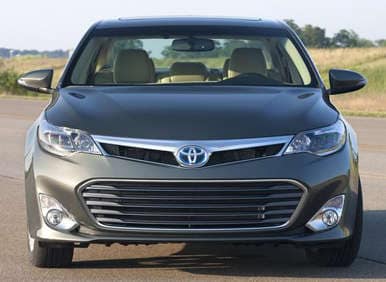Recent Articles
Popular Makes
Body Types
2013 Toyota Avalon First Drive Review and Road Test

Here’s a game of word-association. What comes to mind when you think of the Toyota Avalon? Boring? Comfortable? Conservative? Roomy? Retirement Community?
If your first thought was something related to mature drivers, you aren’t far off. According to Jack Hollis, VP of Marketing for Toyota, the median age of the current Avalon buyer is 67 years old.
Now, having an older demographic for your top model isn’t necessarily a bad thing. The Del Boca Vista crowd has disposable income and is apparently full of very loyal repeat buyers of these Toyota sedans.
In fact, one could argue that Toyota really nailed their target demographic with the Avalon. The sedan has been the Toyota brand flagship in the U.S. since its introduction in 1995. It was a larger sedan based on the Camry and specifically aimed at drivers who formerly bought large American sedans. It’s difficult to conceive of now, but that first-generation Avalon featured a front bench seat and a column-mounted automatic transmission shifter.
Of course, there are challenges to such an aging demographic… let’s just say that it’s much easier to sell a young-person’s car to an older driver than an old-person’s car to a young buyer. And, as any marketing executive knows, you can’t count on repeat buyers forever if they keep aging because at some point, well… they stop aging.
The product defines the brand, so, this all-new 2013 Avalon has a difficult job to do. Toyota engineers and designers were tasked with developing a vehicle that is appealing to a younger buyer, creates a more emotional response, changes the perception of a brand name that has been unwavering in its consistency for 18 years, yet does not alienate loyal customers.
2013 Toyota Avalon: The Basics
Some key brand attributes of the previous Toyota Avalon should transcend age barriers. These include comfort, refinement, reliability, safety and value. It was important for engineers to keep these benefits intact while also focusing on exterior and interior styling, advanced technologies, performance and fuel-economy. These latter changes, Toyota believes, will appeal to younger buyers who see this vehicle as a better reflection of themselves. And by younger buyers, let’s be clear that not every vehicle has to appeal to the 25-35 year-old crowd. Toyota and Scion have other offerings targeted toward the young set. However, a 10 year younger median buyer would be a big win for this new design, according to Toyota marketers.
To accomplish this goal, Toyota tried something new. This is the first Toyota-branded vehicle designed, engineered and built by Americans specifically with the needs of the North-American market in mind. Kevin Hunter and his California-based CALTY design studio came up with the striking new design. In a first for Toyota, the Chief Engineer on the project was another American, Randy Stephens, based in Ann Arbor, Michigan. The Avalon will be built in Kentucky for the U.S. and exported to Canada and a handful of international destinations.
For the first time, Toyota also expanded the Avalon model lineup to include a fuel-sipping hybrid-electric using Toyota’s now-familiar Hybrid Synergy Drive system.
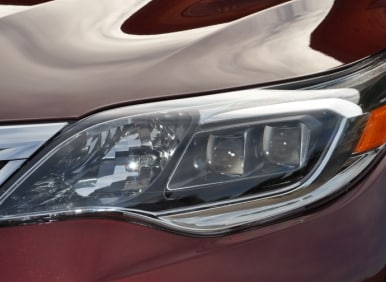
2013 Toyota Avalon: Design
One clear change for this generation is styling. The Toyota Avalon has a longer, lower, and curvier look than the third generation car on essentially the same interior dimensions. It’s definitely more eye catching and photos don’t seem to do justice to the complex curves on the side panels and fenders. Starting at the front are some aggressively styled headlights Toyota refers to as double-eye square projector headlights.
An advantage to designing and engineering the car in the U.S., according to Toyota designers, was the close relationship they had with suppliers during the development of the new car. As an example, they point to those square projector-beam reflectors. These are reportedly the first such application of this design and were developed at Toyota’s behest. The rest of the front end is cleanly styled if perhaps a bit generic in appearance. Again, it’s designed to be expressive without alienating current customers. It is a dramatic departure from the current vehicle’s single large conventional grille but there is no mistaking it for a large Toyota and it is now more closely in line with other products like the smaller Camry.
The body flows smoothly over creases and curves to a deeply angled rear glass and c-pillar. Beauty is in the eye of the beholder but we believe the designers managed to create a handsome design that will look fresh for a while and won’t alienate those important repeat buyers.
Interior passenger dimensions are essentially unchanged from the 2012 Toyota Avalon. Despite the curves and rakish rear slope, the trunk capacity increased a bit over last year’s model from 14.4 cubic feet to 16 on the gasoline model. Despite a trunk-mounted battery pack, even the hybrid Avalon offers a 14 cubic foot trunk with a large and low opening. Again, this is a feature that was deemed appealing to drivers of any age group.
The new Toyota Avalon interior is even more dramatically improved. A layered design to the interior includes a hand-stitched dash, aluminum, wood, chrome and leather. It sounds busy, but designers created an upscale look and every touch point appears well thought out, clearly labeled, and pleasant to use. The car is loaded with all of the expected technology, multiple colorful TFT screens (between the gauges, the touch-screen radio/nav display, and even the HVAC controls on higher trim levels). Kudos goes to Toyota for keeping the two large knobs for the stereo. The touch-sensitive capacitive switches surrounding the basic controls certainly lend a clean and high-tech appearance to the dash but may take a bit of getting used to. We found them easy to activate by accident and the lack of tactile feedback while driving required a bit more care. At least they are clearly labeled and spaced well so there should be a short learning curve for new owners.
Overall, the interior feels roomy, comfortable, modern, and of high quality.
Surprisingly youthful touches include a sporty steering wheel equipped with aggressive thumb indents at 9 and 3 o’clock. There is a standard manual override on the 6-speed automatic shifter for the V6 model and even on the CVT-equipped hybrid. If that isn’t enough, high-line V6 models include metallic paddle shifters mounted on the back of the steering wheel. Yes, you read that right… paddle shifters… on an Avalon. Clearly, Toyota has gone to great lengths to infuse some newfound driving passion into this car. In fact, Toyota executives referred to the new Avalon as the first of seven new (and more exciting) vehicles we’ll see from them over the next year.
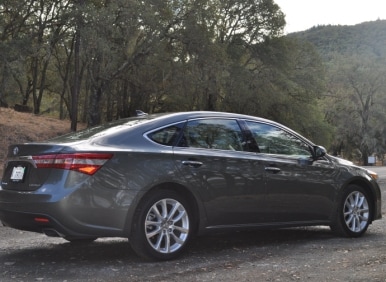
2013 Toyota Avalon: Powertrains
Following the standard Toyota Avalon formula, the volume engine is a 3.5 liter V6 producing 268 hp at 6200 rpm and 248 ft. lb. of torque at 4700 driving the front wheels. Combined with the 6-speed automatic, improved aerodynamics, and a substantial weight loss of 120 lbs from the previous generation, fuel economy is up to 21 city/31 highway from 19/28 last year.
As previously mentioned, Hybrid Synergy Drive technology shared with the new Camry finds its way to the Avalon for the first time for 2013. The new Toyota Avalon Hybrid offers a combined output of 200 hp. 156 hp comes from the new 2.5-Liter Atkinson cycle inline 4 cylinder engine. Fuel economy is a combined 40 mpg (40 city/39 hwy) using regular 87 octane gasoline. 40 mpg from a large entry-level luxury sedan is certainly another benefit that should transcend demographics.
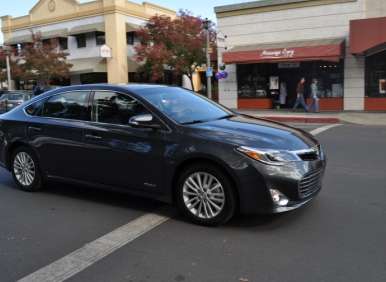
2013 Toyota Avalon: Driving Impressions
Toyota provided a variety of new Avalons for back-to-back comparisons around the hills, curves, and crowded byways of the Napa Valley. The curvy roads really highlighted the significant changes to the Avalon’s chassis. Performance-oriented drivers will appreciate a car with tight body controls and responsive steering. If one is looking for wallow and float, it won't be found here. The vehicle, whether on standard 17” wheels or the 18” inchers on the touring and limited trim levels, simply handles curves without drama. The new electric power steering is notable for doing nothing, well, notable other then directing the car where you want it when you want it. Changing drive modes from “eco” or “normal” to “sport” tightens up the steering a bit and increases the responsiveness of the gas pedal. At one point, we had driven about 10 miles of curvy mountain roads at speed and completely forgot to put the car in “sport” mode. Normal mode was simply that natural and well-calibrated.
Drivers more concerned about comfort shouldn’t be too disappointed, either. The suspension, surprisingly, skews a bit more heavily toward sporting than soft. Perhaps this was done intentionally to leave a few degrees of “luxury” to Lexus-branded models. That is if your definition of luxury is complete isolation. Ours isn’t, and we found the car offered a nice compromise between ride and handling and the ride is certainly still comfortable, just a bit firmer than expected. Again, Toyota was clearly trying to change the perception of the Avalon and to create a more passionate vehicle.
Chassis tuning was an opportunity to both surprise and delight potential buyers. Shoppers used to the old Avalon will certainly be surprised. Whether they are delighted depends on many factors, but they won’t be bored.
Noise levels on all models were controlled thanks to laminated acoustic glass on the windscreen and front door windows. Mechanical vibration and noise are also subdued appropriately but the Avalon doesn’t go all the way to isolation-chamber quiet. Tire noise is minimal even with the 18” wheels but pavement thumps are heard and felt. Wind noise isn’t bothersome, but it isn’t entirely undetectable. It is never unpleasant and passenger conversations are never an issue, but those wishing for complete silence may still find a reason to justify a step up to another Toyota sister brand of luxury sedan.
As one would expect of a modern Toyota, the V6 model was smooth and powerful. The paddle shifters (or manual shifting of the center console) provided quick responses from the six-speed automatic transmission and even elicit a small blip from the throttle during aggressive downshifts. The paddle shifters can also be used even with the transmission level in normal drive mode if a quick override of the transmission controls is required.
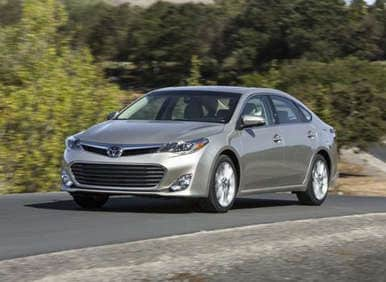
2013 Toyota Avalon: Hybrid Driving Impressions
Personally, we enjoyed the Toyota Avalon Hybrid even a bit more than the V6. The less powerful 4 cylinder and electric combination certainly doesn’t give the same outright thrust as the V6 but it was certainly adequate for what most drivers will ask of the car. Toyota claims a 0-60 time of 8.2 seconds for the new Avalon and in normal driving it was an unobtrusive system. Only when pushed hard did the 4-cylinder gasoline portion of the car make itself heard or felt. Similarly, only the slightest electric whir is noticeable when nearing a complete stop… just enough to remind you that there is an electric motor helping you slow the vehicle. Braking, whether regenerative or mechanical, was likewise unobtrusive. A complete set of gauges and Hybrid data is available on the large color display for those interested. According to this display, we averaged over 42 mpg during a 35-mile stretch of mixed driving and let’s just say we weren’t trying to hyper mile. Under most driving situations, an owner could easily forget to ever play with the EV mode or worry about anything except normal driving and filling the tank every 680 miles.
On curvy roads, the extra weight of the hybrid is masked well. Slightly better weight distribution due to the smaller engine up front and the placement of the heavy battery pack in the rear of the car leads to better balance and a bit less under steer than in the V6.
Hybrid-electric propulsion continues to become more mainstream with every model year. Not needing to stand out from the crowd, the Toyota Avalon hybrid looks like a large luxurious sedan rather then a member of the Prius family. Other than a blue-tinted Toyota badge on the grill, some small chromed “hybrid” badges, and unique 17” alloy wheels there is little to differentiate the hybrid model and little reason to regret one’s decision to choose it over the standard V6. The price gap between gas and hybrid is also shrinking to about $1,750 more for the hybrid in Touring level versus the equivalent V6. This is the lowest hybrid price premium in the Toyota lineup. Toyota marketing executives predict a 20% share for the hybrid models and we don’t see anything about the driving experience to dissuade buyers from this choice.
Trim levels include XLE or Limited with either engine and Toyota has kept options to a minimum… basically choose your trim level and color. There is only one option package sold separately… a technology option for the highline Limited model.

2013 Toyota Avalon: Pricing
Base pricing for the 2013 Toyota Avalon drops nearly $2,200 compared to the 2012. Base V6 XLE models start at $30,990 (before destination fees) and already include leather, 17” alloys, power heated front seats and display audio system with a 6.1” screen.
Moving up the XLE Premium adds a moon roof, backup camera and the three-position driving mode switch along with a few other niceties for a price of $33,195.
XLE Touring models are $35,500. This level includes Toyota’s Entune system (control over phone apps like Pandora), Navigation, 18” wheels, the aforementioned paddle shifters and a Blind Spot Monitor with Rear Cross Traffic Alert.
Full luxury comes in the form of the Toyota Avalon Limited. At $39,650, drivers are treated to everything already mentioned plus softer leather on the heated and now ventilated front seats, a JBL Premium audio system, Toyota’s Safety Connect telematics system and HID headlamps. Avalon Limited passengers will enjoy heated rear seats, a rear sunshade and 3-zone HVAC system with rear-seat controls. Those going full-hog on the options can add the technology package to the Limited and enjoy all the newest technology including Adaptive Cruise Control, Pre-Collision System and Automatic High Beams.
The hybrid synergy drive system is available in all but the base XLE trim package, so the least-pricey gas-sipping Avalon is the XLE Premium and starts at $35,555.
Also new this year is a special edition of the Avalon for livery services… cutting some of the options but adding heated rear seats and climate controls for some lucky airport-bound passengers. Available in either V6 or Hybrid models, the black-car special should provide an interesting fuel-efficient alternative for limousine service providers. The cavernous amount of rear-seat legroom should make this car a popular choice for passengers as well.

2013 Toyota Avalon: Conclusions
It appears that Toyota designers and engineers have found a comfortable balance for the new 2013 Toyota Avalon.
Shoppers who never before considered an Avalon will find an all-new sedan that offers up-to-date design, technology, fuel-efficiency, comfort and surprisingly capable handling. Drivers looking for a luxurious car in the mid $30,000 range with maximum interior space, two solid well-proven engine choices, comfort, and value would be well-served to add the Avalon to their shopping list.
Fans of the previous three generations of the Avalon may be as surprised as the rest of us. Yet, they will find little to dissuade them remaining loyal Avalon customers. The basic traits they loved in their current Avalon remain but the whole package is spiced up tastefully. They may just find themselves taking those curves a bit faster and feeling a bit more stylish this time around.
Test vehicle courtesy of Toyota.
